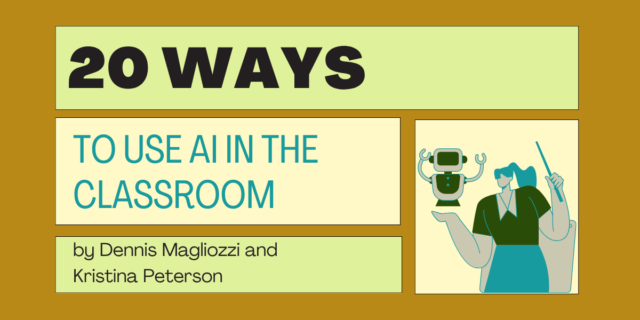
As my sufferings mounted I soon realized that there were two ways in which I could respond to my situation—either to react with bitterness or seek to transform the suffering into a creative force. I decided to follow the latter course.
―Martin Luther King Jr.
Teachers are on the front lines. We are advocates, mediators, magicians, actors, and even healers. Yes, healers. On any given day a teacher can witness a student trying to make sense of struggles in his life. As teachers, we carry students’ stories with us. Some of the stories make us cry, some just about break us, and some transform us.
For me, that transformative moment occurred with Terrence. Terrence sat in the back of the classroom with his head down and his hoodie covering almost everything but his eyes. My plan was to gather on-demand writing samples to use as a formative assessment tool. I reassured the class their writing was not being graded; I just needed to see how they write. When I asked the class to begin, Terrence rolled his eyes and grunted. He lifted his head and assertively announced he wasn’t going to do it and there was nothing I could do about it.
I followed with a simple question, “What’s happening?” He responded with, “Nothing. No one sees me.” What he was telling me at that moment was that he felt invisible. I wanted his writing and he wanted me to know him, to see him. Terrence was partially right that day. He didn’t do the writing assignment, but there was something I could do about it.
As a classroom teacher, I have found myself thinking about how our curriculum encourages students to assimilate, deprives them of choice, and mutes their voices. Our most vulnerable children—children of color, students with special needs, students who are economically disadvantaged, and students who embrace an identity that does not fit perfectly into the agenda of a curriculum map—are facing paralysis in the classroom. How can students like Terrence succeed on someone else’s terms, especially when those terms do not consider who they are or what they need?
What steps could I take to learn more about my students and reframe my classroom practice to meet their needs? One of the first shifts I made in my practice was to rethink my first unit on writing narrative. I included time for the students to share aspects of their lives without the constraints of a genre. Children tell stories, listen to stories, and even watch stories.
Stories have a variety of purposes; they can entertain, teach, and convey larger life messages. I thought about how story can be a window into my students’ lives. This meant slowing down and giving the students a platform to share something about their lives. In previous years, I launched writing workshop by emphasizing the importance of a writing notebook and living like a writer. This year I started by emphasizing the life behind the writer. I carved out time for students to write across genres about their lives and who they are.
It was important to give students choice in what they shared and how they shared. Some students chose to write, some chose to create a mini video, and some chose art. But they all told their stories. During writing workshop, Kate started writing about the experience of a tragic accident in which she lost her brother.
When I was four I was driving home with my brother and stepmom, and out of nowhere a car accident happens! The accident was unpredictable. One was injured and we were staring. People gathered as if someone died. Someone did die. It was someone I truly loved, someone who I will never forget, someone who will always be in my heart. Someone who is my brother. One time, when Josh and I was at our Grandmas house, we were being goofy and wore our dad’s clothes. We wore his pants, shirts and his hats. Another time when we were at my house, I was being goofy so I pretended to be Josh and wore his shoes. I loved those times. Even though people don’t last forever you will still have them right beside you.
Even though Josh might be way up, I still know that everywhere I go Josh will be right beside me. For example, if someone you love is gone, you don’t know how close that person is. I am serious. That person is closer than you think. When I was 7 years old, I used to be super scared of the dark. I would never fall asleep. I felt like I was a cold lonely body. Nobody was there for me but one person. His name was Josh. When I knew he was there, I felt better. I felt like he was actually next to me. Then I finally conquered my fear.
This was the first time she openly shared this experience. Kate’s dad said it took him several years to even talk about what happened and was relieved to have a window into how the accident impacted his daughter. He said if writing is the way to heal, then more people should be doing it.
As a form of reflection, I asked the students, “How does writing help you in your life?” Many said that writing is one way they can share how they truly feel; it helps them understand life.
As part of my Heinemann Fellowship I’ll continue to explore the overarching question that drives my teaching: In what ways can writing increase resiliency and agency in students who face trauma and/or adverse childhood experiences?
I will be researching my own classroom practice and asking how I can make shifts that meet curricular demands and support the social-emotional well-being of students. Specifically, I will be asking what role choice and flexibility play in the writing workshop. Can these shifts help students heal? Are there specific tools teachers can use to support students who face trauma and adversity?
Students like Terrence keep us awake at night. Terrence will continue to face challenges, but as teachers, we can take steps to reframe our classroom practice to embody freedom of choice, flexibility, and an affirmation of student identity. I look forward to finding new pathways and setting up safe spaces in writing workshop to support students as they work and write through life’s challenges.
 Tiana Silvas considers effective teaching to be an intersection of continuous co-constructed learning, self-confidence, and lifelong leaders that emerge from teacher teams and classrooms. Silvas feels that the best way to grow as an education leader is through experience in the classroom saying, “I continue to lead from the trenches.” She says “true leadership isn’t what you do in the moment, but the legacy you leave behind.” She is a 4th Grade Teacher and former Literacy Coach at PS 59
Tiana Silvas considers effective teaching to be an intersection of continuous co-constructed learning, self-confidence, and lifelong leaders that emerge from teacher teams and classrooms. Silvas feels that the best way to grow as an education leader is through experience in the classroom saying, “I continue to lead from the trenches.” She says “true leadership isn’t what you do in the moment, but the legacy you leave behind.” She is a 4th Grade Teacher and former Literacy Coach at PS 59


